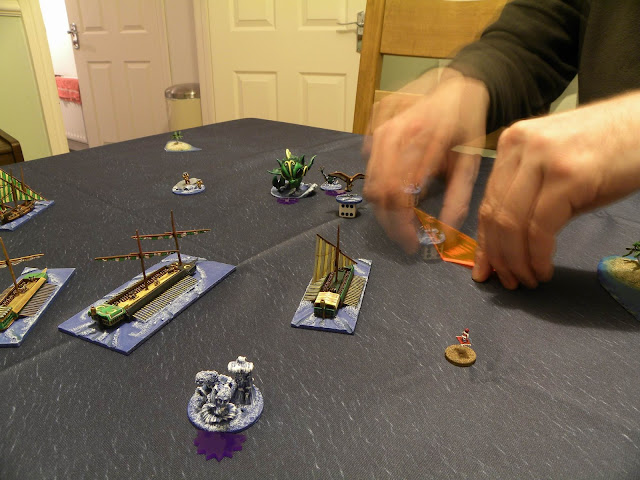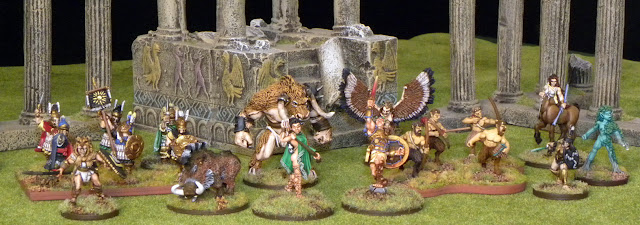It became apparent early on that while galley-based fleets can generally out maneuver sailing fleets, they aren't a patch on creatures. Not only did the monstrosities quite literally run circles around the galleys, but the galleys lack of broadside guns made them particularly vulnerable to this particular foe.
The magical creatures proved very effective but, due to poor rolling, the Barbary sorcerers were rather less so. The windwhisperer on his carpet was doing alright, until the sirens managed to charm the pyromancer on the deck of the galley who then, over successive turns, started setting fire to all of his own friends. In this photo you can see he has just cast a fireball at the carpet rider, setting the carpet alight. In the next turn, the carpet would explode, plunging its rider into the murky depths.
The corsairs finally managed to destroy a creature - but it happened to be the only static one - the cyclopes on their rocky outcrop. The more mobile critters surrounded one of the galliots, overwhelming it and tearing it asunder.
Then the sirens struck again, enchanting the pyromancer...
... and getting him to throw fireballs at the other galliot. It all ended very poorly from there for the Barbary corsairs.
********
In the next game we evened it up a bit. The same creatures of the deep set their sites on a massed 500 odd point fleet consisting of an airship, an indiaman (with windwhispering magic user on board), two ornithopters, a gyrocopter, a galleon, a brig, a jacht and two flotillas of boats.
This game got pretty chaotic with so many models. The rules handled them all fine, but the 1m square board with three islands plus the cyclopes (on their own little isle), meant that most of the models were crammed into a tight space in the middle of the table.
In this shot you can see the catastrophic result of just two turns worth of poor prioritising on my part. Both the galleon and indiaman were wrecked through a combination of shallow water and collisions. All of the flyers set up on dice are up there to show that they are flying at a high altitude.
Meanwhile, too many of my other models managed to fly/sail right off the table because I rolled dice unwisely. About the most effective 'ship' in my fleet were one set of boats that managed to savage the daughters of Aegir (wave nymphs) before being picked on by the sea monster, Triton and the daughters all at the same time.
In this game the roc showed its real worth as a harrier, pursuing the ornithopters and gyrocopter all across the table and using its sharp talons to tear at their canvas and light timber frames.
The second game was, understandably, much less one-sided than the first. Despite my magic user never actually getting to activate in the second game, I think we ironed out any immediate issues with magic. There will be further tweaking to be sure, but at present the two different type of casters and the five different schools of magic each play quite differently giving a nice sense of individuality to you choices when building your fleet. Pyromancers and hydromancers are very aggressive, while mindbenders and terraformers are far more strategic. Windwhisperers feel perhaps the most flexible... but we shall see what happens with further tests.














































